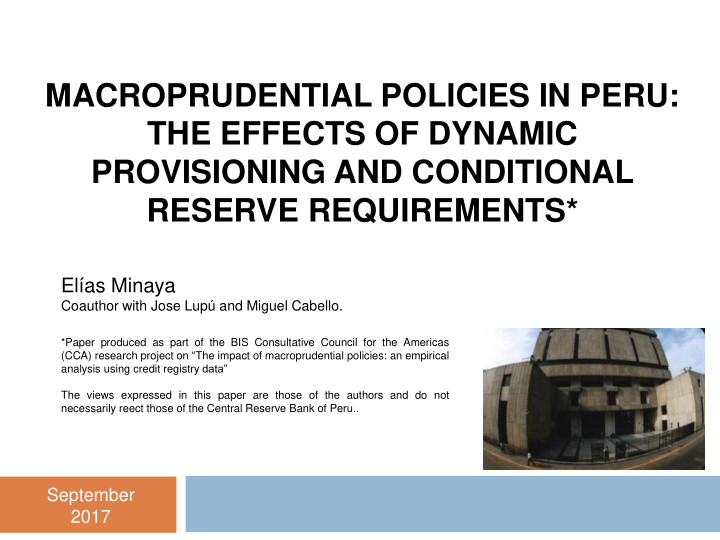



MACROPRUDENTIAL POLICIES IN PERU: THE EFFECTS OF DYNAMIC PROVISIONING AND CONDITIONAL RESERVE REQUIREMENTS* Elías Minaya Coauthor with Jose Lupú and Miguel Cabello. *Paper produced as part of the BIS Consultative Council for the Americas (CCA) research project on “ The impact of macroprudential policies: an empirical analysis using credit registry data” The views expressed in this paper are those of the authors and do not necessarily reect those of the Central Reserve Bank of Peru.. September 2017
Outline 2 1. Motivation 2. Main macro-prudential tools implemented in Peru 3. Data 4. Results 5. Conclusions 6. Agenda
Motivation 3 In the last years, Peru, as many other economies, had been active in the use of macro-prudential tools carried out under the coordination between Central Bank, Supervisory Authority of Banks and the Ministry of Economy. The purpose of the macro-prudential tools implemented in Peru had been limiting the potential adverse effects of an excessive growth of credit over the economy. This paper evaluates the effectiveness of macroprudential policies using micro data at the bank-client level. Main questions to be addressed: What is the impact of MPP on credit? What is the impact of MPP on bank risk? Do responses to macroprudential shock differ by types of banks?
In the past, Peru faced an excessive credit growth. 4 Macroprudential goal: Control the excessive credit growth Total credit (YoY %) 45% Oct-08 39% 40% Dec-07 30% 35% 30% Sep-07 Oct-11 22% 23% 25% Mar-14 Sep-06 20% 19% 14% 15% Average Jun-15 10% 14% 5% Feb-10 4% 0% Dec-04 Dec-05 Dec-06 Dec-07 Dec-08 Dec-09 Dec-10 Dec-11 Dec-12 Dec-13 Dec-14
Main macro-prudential tools implemented in Peru 5 Dynamic provisioning (SBS, Nov-2008). Additional capital requirements for household debt according to the type of credit and the currency granted. (SBS, Nov-2012). Additional capital requirements for financial institutions that give loans to agents that are exposed to exchange risk (SBS, Nov-2012). Tighter liquidity requirements (SBS, Dec-2012). Higher reserve requirements for deposits in foreign currency (BCRP). Additional reserve requirements conditional on their evolution of loans in foreign currency (BCRP).
Dynamic Provisioning: How does it work? Rule for activation depends on GDP 6 Activation’s Rule: At least, one indicator satisfies: 1,- Average GDP (YoY %) of last 30 months passes is higher than 5%. 2,- Average GDP (YoY%) of the last 12 months is outside is higher by 2% to this same indicator a year earlier. Deactivation’s Rule: Average GDP (YoY %) of last 30 months is less than 5%. Average GDP (YoY %) of the last 12 months is lower by 4% to this same indicator a year earlier.
Additional RRs conditional on the evolution of credit in foreign currency 7 At the beginning, the scheme was conditional on credit growth. There were three limits (10%, 15% and 20%) to dollar credit growth. Banks that exceeded those limits faced additional RRs (1.5%, 3% and 5%, respectively). In the case of households, automobile loans and mortgages were imposed with limits of 10% and 20%, and the additional RRs were 0.75% and 1.5%, respectively. In the end of 2014, the previous scheme was changed to a new set-up that required reductions in the balance of dollar loans. Banks had to reduce, by December 2015, the stock of dollar credit to at least 90 percent of the Sep 2013 balance. In the case of households, the reduction was 85% of the Sep 2013 balance.
Recommend
More recommend